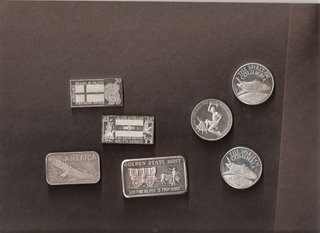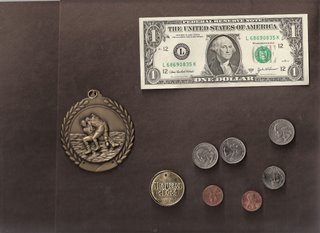Is Real Money “Illegal”?

[Publisher’s note: The following essay is adapted from an article I wrote for The New American and submitted for publication on October 2 — the day I was fired. I actually completed the first draft two hours after learning about my termination; while it was clear to me that it would not be published, I still had an assignment to complete and I’ve always regarded deadlines as sacred.
What follows is essentially the same piece I sent to the magazine on October 2, with a few minor edits for clarity and one small section added to bring the story up to date.]
Is Real Money “Illegal”?
The Feds insist that the privately produced Liberty Dollar – silver coins or storage receipts redeemable for gold or silver on demand – isn’t as genuine as federal reserve notes backed by nothing.
Although people are understandably, and often excessively, preoccupied with money, most people cannot specifically define what it is. Is it paper currency? Is it coins? Is it checks, credit cards, or other negotiable instruments? Should we consider the electronic impulses recorded in our checking and saving accounts as “money”? And why do people accept any or all of the foregoing in exchange for goods and services?
In recent weeks this question has been complicated because of a warning issued by the US Mint regarding the growing use of “Liberty Dollars,” privately issued currency produced by an Evansville, Indiana based group called the National Organization for the Repeal of the Federal Reserve Act and the Internal Revenue Code (NORFED). The organization claims that there is a total of $20 million in Liberty Dollars presently in circulation.
NORFED — founded by Bernard von NotHaus, the former mintmaster of the Royal Hawaiian Mint — has struck coins made of pure silver, using silver “blanks” produced by the Sunshine Mint in Coeur d’Alene, Idaho. The Sunshine Mint is reportedly the same facility that produces all of the blanks used by the US Mint to create its collectible coins. It also provides safe, audited storage for the gold and silver used to back Liberty Dollar notes, which are very attractive, multi-colored storage receipts, each of which is infused with a computer-readable strip that makes counterfeiting extremely difficult. The notes, which do not advertise themselves as legal tender, are redeemable on demand in gold or silver.
The coins, as well as the metal-backed notes, are distributed through a national network of Regional Currency Offices (RCOs), and accepted by merchants who advertise their willingness to accept them in barter for goods and services. Many other businessmen who are not part of the Liberty Dollar movement have been willing to accept the beautiful silver coins (called “medallions” by RCOs for legal reasons) as well.
Many see the Liberty Dollar as a healthy hedge against inflation and a splendid example of mutually beneficial barter. The Feds, however, are trying to convince the public – through insinuation, not through formal prosecution – that NORFED is engaged in fraud.
“We don’t want consumers to be fooled,” insists U.S. Mint spokeswoman Becky Bailey. “The United States Mint is the only entity that can produce coins.”
This isn’t true, of course, since many companies produce beautiful gold, silver, platinum, and palladium bullion coins. What Ms. Bailey apparently meant to say was that none of these companies has the government’s permission to circulate those coins as money. But government’s permission is not required, where the transaction takes place between fully informed parties — sellers willing to accept privately produced coins or storage notes for precious metal, and buyers with sufficient specie to pay the asking price.
Real vs. “Real” Money
Under federal law, the U.S. Dollar, in various denominations, is defined as “legal tender,” meaning that it must be accepted as payment for “all debts, public and private.” Since August 15, 1971, when President Richard Nixon severed the last links between the dollar and gold, the Federal Reserve Note (FRN) has not been backed by precious metals or commodities of any kind. Its value is provided by the “full faith and credit” of the U.S. Government – which means, in practice, that people accept it in payment because the federal government forces them to.
This is a relatively recent development in our nation’s history, the result of a process that began with the creation of the Federal Reserve System in 1913 and continued until our “money” was completely divorced from precious metals in 1971.
Until 1965, minted US government coins in circulation contained at least some precious metal; that is no longer the case. Contemporary dimes and quarters are made of a nickel/copper alloy that is worth less than the face value of the respective coins; even the lowly penny, once made from copper, is now composed of zinc.(Curiously, however, the nickel coin presently contains six cents’ worth of the metal, but this anomaly likely won’t last much longer.)
The U.S. Constitution specifies that Congress has the power to “coin” money, and to punish counterfeiting; it also specifies that no state can “make anything but gold and silver coin a tender in payment of debts” — a prohibition that applies, in principle, to Congress as well, since nothing in the Constitution authorizes the creation of paper money, let alone fiat currency.
The Founders, remembering the disastrous experience of issuing the fiat “Continental” currency during the War for Independence, inscribed the principle of hard money in the Constitution. In 1792, Congress passed the Coinage Act, a measure defining a “dollar” as a specific quantity – 371.25 grams – of silver. For most of our nation’s history – the span of 130 years between 1787 and 1913 – gold and silver, as well as notes redeemable in the same, issued by governments and private banks, were money.
However, despite the unambiguous language of the Constitution and the 1792 coinage act, as well as the balance of our national history,a federal statute criminalizes the use of gold and silver in transactions as a form of “counterfeiting and forgery.”
REAL money — silver bullion coins and bars. Use it instead of the regime’s officially sanctioned counterfeit, and you may go to jail.
Chapter 18, section 486 of the United States Code declares:
“Whoever, except as authorized by law, makes or utters or passes, or attempts to utter or pass, any coins of gold or silver or other metal, or alloys of metals, intended for use as current money, whether in the resemblance of coins of the United States or of foreign countries, or of original design, shall be fined under this title or imprisoned not more than five years, or both.”
According to the US Mint’s Becky Bailey, using Liberty Dollars, or any other form of gold or silver coin, “as legal tender is a violation of federal law.”
I asked Bailey to consider a hypothetical question: If an individual went to a local diner and offered a Liberty Dollar in exchange for a meal, and the proprietor agreed to provide the service on those terms, “is that transaction a crime?”
“Yes,” she replied. “I’m not an attorney, but our legal team has looked this over carefully, and they’re convinced that exchanging gold and silver medallions for goods or services as if they were real currency – including in barter – is a violation of 18 USC section 486.”
Pointing out that the U.S. Constitution authorizes only the use of gold or silver as legal tender, I asked: “How can it be a federal crime to use the only legal tender recognized by the Constitution in private transactions?” She immediately became very defensive.
“Look, do you want to debate the legal and constitutional issues?” she asked with some asperity. Assured that I was only asking her to explain a factual contradiction, Bailey insisted that the issue was moot, since “we did go off the gold standard.”
“U.S. Attorneys are receiving complaints and phone calls from merchants and local authorities across the country about the use of the Liberty Dollar medallions as currency,” she continued. “We don’t want consumers to be fooled.”
Are prosecutions forthcoming? I asked.
“We’re not an enforcement agency,” Bailey replied. “I don’t know if law enforcement agencies are planning to prosecute. But we’re convinced that the use of the Liberty Dollars is a violation of federal law.”
The U.S. Secret Service, which is the agency in charge of investigating counterfeiting, offers a view much different from that expressed by Ms. Bailey. Kevin Miller of the Secret Service’s field office in Spokane, told the Missoulian (.pdf)last year that using the Liberty coins is perfectly legal when they’re accepted voluntarily.
“It’s kind of like Wally World coins or Disney dollars,” Miller opined a year ago, referring to scrip or tokens used at amusement parks. “The merchant can accept them, just like bartering. But it’s not considered counterfeit because there’s no U.S. Obligation.”
More recently, however, federal prosecutors have been making threatening noises similar to those made by the US Mint’s Becky Bailey.
“Although we haven’t had any of these types of cases in Montana yet, the statute says using one of these coins as legitimate money could be a crime,” assistant U.S. Attorney for Montana Kurt Alme tolde the October 15 Missoulian. “It looks like if you make or attempt to pass a coin of gold or silver as current money it’s a crime.”
There it is: In the land of fiat — that is to say, phony — money, using the real article is a crime.
Bogus money, valuable trinkets: The Federal Reserve Note and federally issued coins have less intrinsic value than the pewter medallion on the left — a Bronze Medal I won in a wrestling tournament a few years ago — and the plastic “coin” one of my children received at a church activity involving Bible study. At least those items reflect honest effort and achievement.
How is anyone injured by accepting silver or gold instead of a debt instrument or a worthless slug?
The Missoulian takes a stab at answering this question by insinuating that the Liberty Dollar is overvalued and thus a form of fraud.
“The Liberty Dollar coins are made of 1 troy ounce of 0.999 fine silver and have a face value of $20,” notes the paper. “But the coin’s face value soars above market prices for the same weight of silver, which is currently about $10.45 an ounce.” (As this is written, the spot price of silver is north of $12.00 an ounce.)
Once again, if both parties to the transaction are fully informed and willing, what injury results? And besides, this critique of the Liberty Dollar doesn’t disclose the “market price” of gaudily decorated rag paper, or why we should be forced to accept little rectangles of the same as if they had some innate value.
No such thing as bad publicity
For their part, NORFED and the Liberty Dollar campaign perceive the recent attention from the US Mint and the mainstream press to be an intimidation campaign that appears to be backfiring.
“What the US Mint asserted in its press release, and what was picked up by various news outlets – from USA Today to CNN and CBS, with some of it ripping into local coverage – was nothing more than a handful of vague allegations and insinuations of fraud,” Michael Johnson, Executive Director of the Liberty Dollar campaign, told me in a telephone interview.
“We’ve been around for eight years, and in that time we’ve made repeated inquiries to the Treasury Department, the Secret Service, and several other federal agencies. To date, we’ve received no notice of any kind from any government agency that anything we’ve done is illegal or unethical. They’ve not contacted us, they’ve not approached us in any way. Our chief legal counsel in Washington has tried to communicate with the Treasury Department’s legal counsel. But they literally won’t even return our phone calls.”
If the intent is to scare people away from the Liberty Dollar movement, the campaign may have backfired.
“I think the Feds gave us about $40 million in free publicity with their attacks on the Liberty Dollar,” commented Matthew Pitagora, who operates a Regional Currency Office (RCO) out of his Evergreen Valley Water Company in San Jose, California.
“What we’re doing isn’t just an effort to promote the use of real money through private barter,” Pitagora told me. “It’s also a First Amendment campaign to inform the public about the destruction of their wealth through the use of fiat currency, and hopefully to energize the public to petition our elected representatives for a return to legal, constitutional money – gold and silver. So when the Feds resorted to what I consider attempted information terrorism – trying to scare our customers away – it really worked to our benefit. Millions of people who didn’t know about the existence of a legal, constitutionally sound alternative to the worthless FRNs [Federal Reserve Notes] now do, and that will certainly help our efforts.”
USA Today and the other media outlets that republished the US Mint’s press release were acting as stenographers rather than journalists, dutifully retailing what they had been fed by the Feds. The media had been given an opportunity to hear and report NORFED’s side of the story earlier.
“In early August, Mr. Von Not Haus and some of his associates held a press conference outside the Federal Reserve’s headquarters in New York,” recalled Michael Smith to The New American. “They held up a giant `debt balloon’ to illustrate the impact of inflation in driving our nation into incipient bankruptcy. The message was: the dollar is headed for collapse, you’d better move to protect your personal wealth – and the Liberty Dollar is a good way to go.”
The press conference received no coverage at all in the mainstream media. However, Smith suggests, “the negative coverage of Liberty Dollar triggered by the US Mint’s press release could have been a response to our efforts to raise our profile. If that was the intention, though, it didn’t work out quite the way they had planned, because we’re doing about double the amount of business now that we were before” the hit piece appeared in USA Today.
For now, explains Pitagora, “we’ll keep circulating the Liberties. I take them here at my business. When people are interested I’ll give them to customers in change, which means that I’m actually giving them back something more valuable than the FRNs they use to pay me. That’s a great feeling.”
Content retrieved from: http://freedominourtime.blogspot.com/2006/10/is-real-money-illegal.html.






























